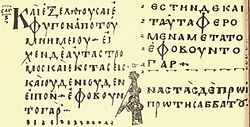Codex Regius (New Testament)
|
New Testament manuscript |
|

Ending of Mark
|
|
| Name | Regius |
|---|---|
| Sign | Le |
| Text | Gospels |
| Date | 8th century |
| Script | Greek |
| Now at | National Library of France |
| Size | 23.5 cm by 17 cm |
| Type | Alexandrian text-type |
| Category | II |
| Hand | badly written |
| Note | marginalia |
Codex Regius designated by siglum Le or 019 (in the Gregory-Aland numbering), ε 56 (von Soden), is a Greek uncial manuscript of the New Testament, dated paleographically to the 8th century. The manuscript is lacunose. It has marginalia.
The codex contains 257 thick parchment leaves (23.5 cm by 17 cm), with an almost complete text of the four Gospels. The codex contains five lacunae (Matt 4:22-5:14, 28:17-20, Mark 10:16-30, 15:2-20, John 21:15-25).
The text is written in two columns per page, 25 lines per page, in large, not round uncial letters. It has breathings (Spiritus asper, Spiritus lenis), and accents often added wrongly. It is carelessly written by an ignorant scribe. The letter phi is enormously large, the letter alpha presents the last stage of the uncial script.
The text is divided according to the κεφαλαια (chapters), whose numbers are given at the margin, and their τιτλοι (titles) at the top of the pages. It contains also the tables of the κεφαλαια (tables of contents) before each Gospel. There is also another division according to the Ammonian sections, with references to the Eusebian Canons at the margin. It contains lectionary markings at the margin (for liturgical reading).
It was badly written by the scribe, who was more probably Egyptian than Greek, with a tendency for writing Coptic rather than Greek.
...
Wikipedia
